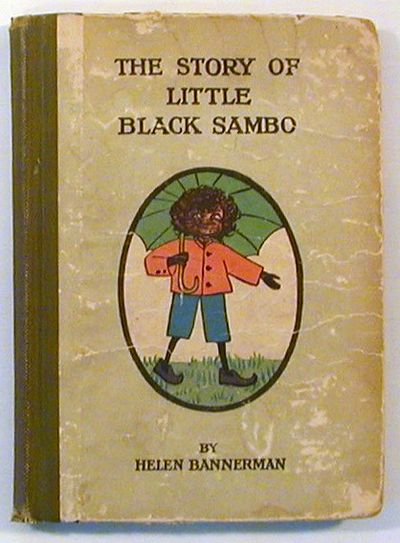

The tigers are fighting over which one of them is the prettiest, and they get so angry at each other that they take off all the fancy clothes and start fighting. He hears the tigers coming, so he hides behind a tree. At this point, the boy is sad, because he doesn't have any of his fancy clothes anymore (he doesn't seem to care that he's in his underwear). Another tiger gets his shoes, although he protests, "What am I gonna do with two shoes? I've got four feet." And the kid says, "Put them on your ears," and the tiger's like, "What a great idea!" A fourth tiger takes the umbrella, after protesting that he can't hold it, and the kid tells him to tie a knot in his tail to hold it. The tiger says, "I'm gonna eat you," and the kid says, "Don't eat me! I'll give you my jacket." And so the tiger goes, "Okay." And then the boy meets another tiger who threatens him into giving the tiger his pants. Then he goes out for a walk in the jungle and meets a tiger.

The story: A little boy's mother makes him a jacket and some pants, and his dad buys him an umbrella and some pretty shoes. The preface to the edition of the book I read says, "Sambo became, to some, a symbol of racism, and to others, he remained a long-remembered favorite." The name "Sambo" had already been in use for some time as a stereotypical "black" name, but it's hard to tell how derogatory the name was until after Bannerman's book became popular. Pointing out his race, and having his race be a part of his name, is just tacky. But the first sentence is, "Once upon a time there was a little black boy, and his name was Little Black Sambo." There's really nothing inherently wrong with that, except that his race is irrelevant to the story. There are no tigers in the Southern United States, and ghi (or ghee) is even stated to be from India.

Clearly the story is set in India, and I don't know why Bannerman decided to draw the characters as awful stereotypes from the American South. The characters don't act in a particularly stereotypical way, and the message of the book isn't inherently bad. Tiger, don't eat me up, and I'll give you my beautiful Purple Shoes with Crimson Soles and Crimson Linings.This book is only bad because of Helen Bannerman's original racist drawings and the names of the characters. And Little Black Sambo said, "Oh! Please Mr. Originally published into a Dumpy Book, this only authorized American Edition up to that time. Illustrations are intended to replicate those of the originals drawn and published by Bannerman when she lived in India with her husband and two daughters in the late 1890's. Illustration bleed on some facing pages, aging to edges of DJ, otherwise very fine. iv, 12 - 56, with color illustrations on the recto of each page and text on the verso. Red cloth with titling in black on spine and cover along with illustration of tiger holding a parasol with his tale.


 0 kommentar(er)
0 kommentar(er)
